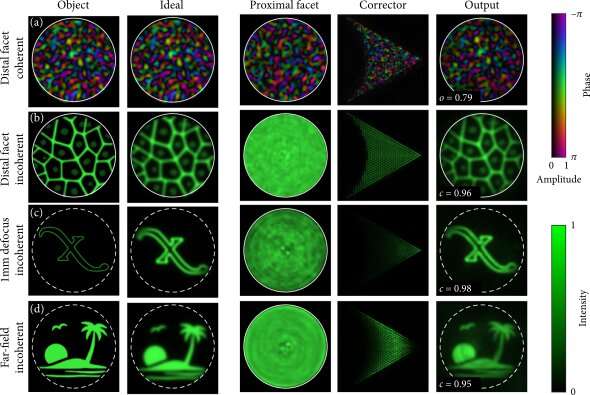A new optical inversion strategy for unscrambling light propagation through multimode optical fibers

Multimode optical fibers (MMFs) are hair-thin strands of glass that are ubiquitous in light-guiding applications. Their development has gone hand-in-hand with the huge growth in rapid transmission of information across the world.
The tiny footprint of MMFs also makes them interesting candidates for next generation micro-endoscopes, to deliver optical microscopy deep into the body. However, the practical information capacity of MMFs is limited by modal dispersion—a mechanism which scrambles the spatial information propagating through MMFs.
Thus the direct transmission of images through MMFs is extremely challenging: an image projected onto one end is unrecognizably scrambled by the time the light reaches the other end. Pioneering research in the last decade has shown how the optical scrambling caused by MMFs can be measured and undone. Now a team of researchers from University of Exeter and Leibniz Institute of Photonic Technology have built on this idea, and propose a new imaging strategy, called optical inversion.
The research was published in Intelligent Computing.
"The majority of imaging techniques demonstrated so far rely on raster-scanning or sequential pattern projection, essentially meaning that light is unscrambled one spatial mode at a time." Lead author Dr. Unė Būtaitė said,
"This currently precludes the delivery of wide-field imaging techniques through MMFs. For example, there is currently no way to conduct wide-field super-resolution imaging at the tip of an MMF—which would be a very desirable way to gain deeper understanding of biological processes inside the body."
To overcome this issue, researchers propose and design a passive optical device, referred to as an optical inverter. Dr. Būtaitė explained, "Our inverter can be understood as a bespoke scattering medium, designed to be complementary to an MMF so as to undo its optical effects."
The spatial information is scrambled after the light emanating from the scene is propagated through MMF, but the optical inverter scrambles the light in exactly the opposite way to the fiber, making it possible to reform the image of the scene passively, and in an all-optical manner in a few nanoseconds.
Different scenarios were simulated to study the performance of the researcher's optical inverter design. The results show that an optical inverter has the potential to achieve single-shot wide-field imaging and super-resolution imaging through MMFs. In addition, by incorporating optical memory effects into its design, the optical inverter can dynamically adapt to see through flexible fibers.
Dr. David Phillips, senior author on the project said, "The key advantage of our concept is that it renders possible any form of wide-field microscopy at the tip of a hair thin strand of MMF—which can potentially be loaded into a needle to view scenes deep inside the body. This includes powerful new imaging techniques such as localization-based super-resolution imaging, along with other emerging forms of parallelized super-resolution microscopy, structured illumination microscopy and single-objective light sheet microscopy."
"Furthermore, single-shot wide-field imaging at any distance beyond the distal end of a short length of MMF also becomes possible."
In the future, the researchers predict other applications for this research. Dr. Phillips said, "The optical inversion strategy we have described here can potentially be extended to unscramble light that has passed through other objects, such as photonic crystal waveguides, photonic lanterns or biological tissue."
"Finally, we anticipate that all-optical inversion of scattered light will find an array of applications beyond optical imaging: benefiting the fields of mode division multiplexing for high capacity optical communications, as well as quantum cryptography and classical and quantum optical computing. We are excited to see where this technology goes."
More information: Unė G. Būtaitė et al, How to Build the "Optical Inverse" of a Multimode Fibre, Intelligent Computing (2022). DOI: 10.34133/2022/9816026
Provided by Intelligent Computing




















